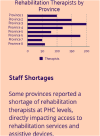Document review of the paper-based implementation of the Framework and strategy for disability and rehabilitation in Gauteng, South Africa
- PMID: 39999102
- PMCID: PMC11856559
- DOI: 10.1371/journal.pone.0315778
Document review of the paper-based implementation of the Framework and strategy for disability and rehabilitation in Gauteng, South Africa
Abstract
Background: The prevalence of disability is on the rise globally and in South Africa, with a high number of unmet needs and poor actualisation of the health rights of persons with disabilities. A tool to realise these rights is health policy, such as the framework and strategy for disability and rehabilitation (2015-2022)(FSDR). There are limited data on the implementation outcomes of the FSDR.
Objective: To review the implementation of the FSDR according to the paper-based provincial reports.
Methods: The study conducted a document review and utilised a concurrent mixed-method design, combining qualitative and quantitative data extracted from paper-based evaluation templates developed by the South African National Department of Health (NDoH). The qualitative analysis involved thematic coding using the RE-AIM framework to examine the FSDR's implementation across eight provinces, while quantitative data, such as frequencies and percentages, provided supplementary insights.
Results: The quantitative results revealed that 87% of the reports from provinces reported physical accessibility to the FSDR, and 62% of provinces received training on the implementation of the FSDR. Only two out of eight provinces have conducted monitoring and evaluation since implementing the FSDR in 2015. Qualitative findings revealed poor reach and adoption of the FSDR owing to a lack of implementation training for end users. The lack of indicators resulted in poor maintenance of the FSDR, as well as the lack of human resources and equipment which resulted in the reduced efficacy of the FSDR.
Conclusion: The FSDR has not achieved its full level of implementation due to numerous barriers, such as lack of resources, human capacity, and training on implementation.
Copyright: © 2025 Hussein El Kout et al. This is an open access article distributed under the terms of the Creative Commons Attribution License, which permits unrestricted use, distribution, and reproduction in any medium, provided the original author and source are credited.
Conflict of interest statement
The authors have declared that no competing interests exist.
Figures






Similar articles
-
Understanding Barriers and Facilitators to Disability and Rehabilitation Policy Implementation in Gauteng, South Africa: A Qualitative CFIR-Informed Study.Health Sci Rep. 2025 Mar 4;8(3):e70515. doi: 10.1002/hsr2.70515. eCollection 2025 Mar. Health Sci Rep. 2025. PMID: 40046100 Free PMC article.
-
A review of the framework and strategy for disability and rehabilitation services in South Africa.Afr J Disabil. 2022 Dec 15;11:893. doi: 10.4102/ajod.v11i0.893. eCollection 2022. Afr J Disabil. 2022. PMID: 36567920 Free PMC article.
-
South African medical rehabilitation services delivery: a mixed method exploring the views of stakeholders on availability, accessibility, quality, affordability, equity, effectiveness, and efficiency.Pan Afr Med J. 2024 Aug 7;48:159. doi: 10.11604/pamj.2024.48.159.43199. eCollection 2024. Pan Afr Med J. 2024. PMID: 39619408 Free PMC article.
-
What do the implementation outcome variables tell us about the scaling-up of the antiretroviral treatment adherence clubs in South Africa? A document review.Health Res Policy Syst. 2019 Mar 14;17(1):28. doi: 10.1186/s12961-019-0428-z. Health Res Policy Syst. 2019. PMID: 30871565 Free PMC article. Review.
-
To what extent is Fetal Alcohol Spectrum Disorder considered in policy-related documents in South Africa? A document review.Health Res Policy Syst. 2019 Apr 29;17(1):46. doi: 10.1186/s12961-019-0447-9. Health Res Policy Syst. 2019. PMID: 31036004 Free PMC article. Review.
References
-
- Pettinicchio D, Maroto M. Who counts? measuring disability cross-nationally in census data. J Sur Stat Methodol. 2021;9(2):257–84. doi: 10.1093/jssam/smaa046 - DOI
MeSH terms
LinkOut - more resources
Full Text Sources
Medical

